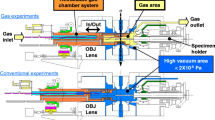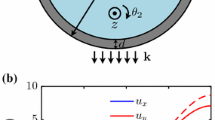Abstract
This paper describes the development of a high vacuum fracture rig for delaminating functionalized silicon surfaces. The main focus here is on examining molecular interactions by functionalizing the silicon surfaces with carboxyl and diamine terminated self-assembled monolayers (SAMs). However, many other interactions can be considered. The crack front location and normal crack opening displacements (NCOD) are measured by infrared crack opening interferometry (IR-COI). This allows the normal traction-separation relation of the interactions to be determined. Some mixed-mode fracture experiments were conducted on silicon/carboxyl/diamine/silicon sandwich specimens in ambient and high vacuum. Interesting differences in behavior were noted.









Similar content being viewed by others
References
Kojio K, Ge S, Takahara A, Kajiyama T (1998) Molecular aggregation state of n-octadecyltrichlorosilane monolayer prepared at an air/water interface. Langmuir 14:971–974
Ulman A (1991) An introduction to ultra thin organic films from langmuir-blodgett to self-assembly. Academic Press, Inc
Ulman A (1996) Formation and structure of self-assembled monolayers. Chem Rev 96:1533–1554
Zhuk AV, Evans AG, Hutchinson JW, Whitesides GM (1998) The adhesion energy between polymer thin films and self-assembled monolayers. J Mater Res 13:3555–3564
Kent MS, Reedy ED, Yim H, Matheson A, Sorenson J, Hall J, Schubert K, Tallant D, Garcia M, Ohlhausen T, Assink R (2004) Using self-assembling monolayers to study crack initiation in epoxy/silicon joints. J Mater Res 19:1682–1695
Mello AV, Liechti KM (2006) The effect of self-assembled monolayers on interfacial fracture. J Appl Mech 73:860–870
Bhushan B (1999) Handbook of micro/nano tribology. CRC Press
DeBoer MP, Mayer TM (2001) Tribology of MEMS. MRS Bull 26:302
Maboudian R, Ashurst WR, Carraro C (2002) Tribological challenges in micromechanical systems. Tribol Lett 12:95–100
Romrig ADJ, Dugger MT, McWhorter PJ (2003) Materials issues in microelectromechanical devices: science, engineering, manufacturability and reliability. Acta Materialia 51:5837–5866
Houston JE, Kim HI (2002) Adhesion, friction and mechanical properties of functionalized alkanethiol self-assembled monolayers. Acc Chem Res 35:547–553
Carpick RW, Agraït N, Ogletree DF, Salmeron M (1996) Variation of the interfacial shear strength and adhesion of a nanometer-sized contact. Langmuir 12:3334–3340
Wang M, Liechti KM, Srinivasan V, White JM, Rossky PJ, Stone TM (2006) A hybrid molecular-continuum analysis of IFM experiments of a self-assembled monolayer. J Appl Mech 73:769–777
Johnson KL, Kendall K, Roberts AD (1971) Surface energy and the contact of elastic solids. Proc Roy Soc Lond Math Phys Sci 324(1558):301–313
Derjaguin RV, Muller VM, Toporov YP (1975) Effect of contact deformations on the adhesion of particles. J Colloid Interface Sci 53:314–326
Maugis D (1992) Adhesion of spheres: the JKR-DMT transition using a Dugdale model. J Colloid Interface Sci 150:243–269
Frisbie CD, Rozsnyai LF, Noy A, Wrighton MS, Lieber CM (1994) Functional group imaging by chemical force microscopy. Science 265:2071–2074
Swalen JD, Allara DL, Andrade JD, Chandross EA, Garoff S, Israelachvili J, McCarthy TJ, Murray R, Pease RF, Rabolt JF, Wynne KJ, Yu H (1987) Molecular monolayers and films. Langmuir 3:932–950
Tong QY, Gösele U (1999) Semiconductor wafer bonding: science and technology. Wiley, New York
Maszara WP, Goetz G, Caviglia A, Mckitterick JB (1988) J Appl Phys 64:4943
Petzold M, Bagdahn J, Katzer D (1999) Microelectron Reliab 39:1103
Turner KT, Spearing SM (2008) Accurate characterization of wafer bond toughness with the double cantilever beam specimen. J Appl Phys 103:013514
Tadepalli R, Turner KT, Thompson CV (2008) Mixed-mode interface toughness of wafer-level Cu-Cu bonds using asymmetric chevron test. J Mech Phys Solid 56(3):707–718
Tsau CH, Spearing SM, Schmidt MA (2004) Characterization of wafer-level thermocompression bonds. J Microelectromech Syst 13(6):963–971
Charalambides PG, Lund J, Evans AG, McMeeking RM (1989) A test specimen for determining the fracture resistance of bimaterial interfaces. J Appl Mech 56:77–82
Higashi GS, Becker RS, Chabal YJ, Becker AJ (1991) Comparison of Si(111) surfaces prepared using aqueous solutions of NH[sub 4]F versus HF. Appl Phys Lett 58(15):1656–1658
Wakamatsu M (2008) Fracture at the molecular level, in aerospace engineering and engineering mechanics. University of Texas at Austin, Austin
Wang M, Liechti KM, Wang Q, White JM (2005) Self-assembled silane monolayers: fabrication with nanoscale uniformity. Langmuir 18:1848–1857
Hutchinson JW, Suo Z (1992) Mixed mode cracking in layered materials. Adv Appl Mech 29:63–199, 29
Liechti KM (1993) On the use of classical interferometry techniques in fracture mechanics. In: Epstein JS (ed) Experimental techniques in fracture, chapter 4, IIIth edn. VCH Publishers, New York, pp 95–124
Li VC, Chan C-M, Leung CKY (1987) Experimental determination of the tension-softening relations for cementitious composites. Cem Concr Res 17:441–452
Sorensen BF, Jacobsen TK (2003) Determination of cohesive laws by the J integral approach. Eng Fract Mech 70(14):1841–1858
Sorensen BF, Kirkegaard P (2006) Determination of mixed mode cohesive laws. Eng Fract Mech 73(17):2642–2661
Högberg JL, Sorensen BF, Stigh U (2007) Constitutive behaviour of mixed mode loaded adhesive layer. Int J Solids Struct 44:8335–8354
Zhu Y, Liechti KM, Ravi-Chandar K (2009) Direct extraction of rate-dependent traction-separation laws for polyurea/steel interfaces. Int J Solids Struct 46(1):31–51
Parmigiani JP, Thouless MD (2007) The effects of cohesive strength and toughness on mixed-mode delamination of beam-like geometries. Eng Fract Mech 74:2675–2699
Turner KT, Spearing SM (2006) Mechanics of direct wafer bonding. Proc Roy Soc A 462:171–188
Miki N, Spearing SM (2003) Effect of nanoscale surface roughness on the bonding energy of direct-bonded silicon wafers. J Appl Phys 94:6800–6806
Tromans D, Meech JA (2002) Fracture toughness and surface energies of minerals: theoretical estimates for oxides, sulphides, silicates and halides. Miner Eng 15(12):1027–1041
Cole DJ, Payne MC, Csanyi G, Spearing SM, Ciacchi LC (2007) Development of a classical force field for the oxidized Si surface: Application to hydrophilic wafer bonding. J Chem Phys 127(20):204704–204712
Higashi GS, Chabal YJ, Trucks GW, Raghavachari K (1990) Ideal Hydrogen Termination of the Silicon (111) Surface. Appl Phys Lett 56:656
Acknowledgements
This work was supported by the Department of Energy (Grant No. DE-FG02-06ER46303). Boris Doynov, an undergraduate research assistant with the group, was very effective in assisting with SAM deposition and diagnostics. Several members of the Chemistry and Biochemistry Department at UT Austin were extremely helpful. In particular, the authors would like to thank Ben Hahn and Dr. Yangming Sun for their generous support and advice with the XPS measurements. All ellipsometry measurements were kindly performed by Alan May, while he was a PhD student in Professor Stevenson’s group.
Author information
Authors and Affiliations
Corresponding author
Rights and permissions
About this article
Cite this article
Liechti, K.M., Na, S.R., Wakamatsu, M. et al. A High Vacuum Fracture Facility for Molecular Interactions. Exp Mech 53, 231–241 (2013). https://doi.org/10.1007/s11340-012-9625-1
Received:
Accepted:
Published:
Issue Date:
DOI: https://doi.org/10.1007/s11340-012-9625-1




